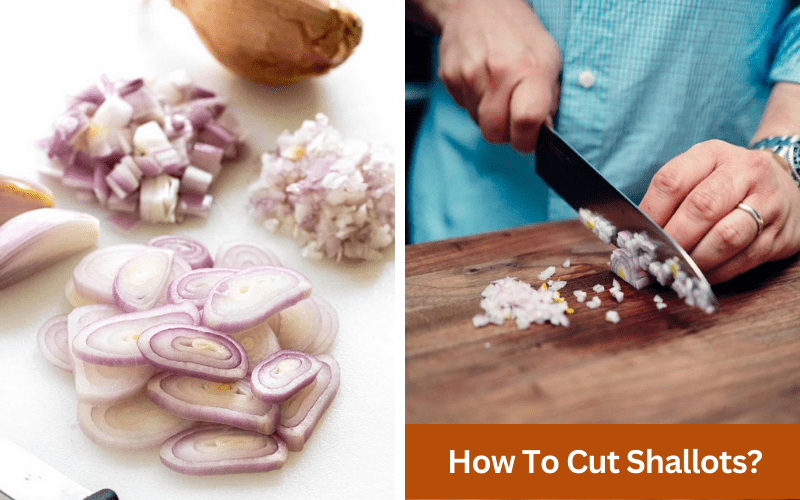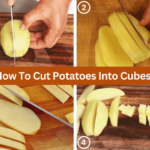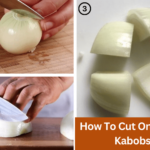How to cut shallots? This seemingly simple question may elicit a variety of answers, ranging from “chop them like onions” to “slice them thinly for a delicate flavor”. Shallots may look like miniature onions, but their unique flavor and delicate texture require a slightly different approach when it comes to preparing them. While many home cooks may shy away from using shallots in their recipes, learning how to cut shallots properly can open up a world of culinary possibilities. In this article, we’ll explore the surprising benefits of cooking with shallots and provide a step-by-step guide on how to cut shallots like a pro.
See more: How To Cut Onions For Fajitas? A Step-by-Step Guide
Understanding Shallots
Shallots are a type of onion that are used in a variety of cuisines around the world. They are known for their distinct flavor and versatility in recipes.
Definition of shallots
Shallots are a type of onion that have a milder, sweeter flavor than traditional onions. They are members of the Allium family and are closely related to garlic, leeks, and chives. Shallots are typically smaller and more elongated than onions, with a brown or reddish papery skin that is removed before cooking.
Comparison with other types of onions
While shallots are similar to onions in flavor and appearance, they are generally considered to be more delicate and nuanced in flavor. They have a sweeter, more subtle taste than onions, and are often used in recipes where a milder onion flavor is desired. Shallots also tend to have a softer texture than onions, and can be eaten raw or cooked.
Varieties of shallots
There are several varieties of shallots, including French grey shallots, which are the most prized and commonly used in cooking. Other varieties include pink shallots, which have a sweeter and milder flavor, and Dutch yellow shallots, which are larger and have a more pungent flavor.
Nutritional health benefits of shallots
Here are some nutritional benefits of shallots:
- Vitamin B6: Shallots are a good source of vitamin B6, which is important for brain function, metabolism, and immune system health.
- Vitamin C: Shallots contain vitamin C, which is important for immune system health, skin health, and wound healing.
- Potassium: Shallots are a good source of potassium, which is important for maintaining healthy blood pressure and heart function.
- Manganese: Shallots are a good source of manganese, which is important for bone health, wound healing, and metabolism.
- Antioxidants: Shallots contain antioxidants such as quercetin and kaempferol, which can help protect against cell damage and chronic disease.
- Allicin: Shallots contain allicin, a compound that has been shown to have antibacterial and anti-inflammatory properties.
- Fiber: Shallots are a good source of fiber, which can help regulate digestion, lower cholesterol levels, and maintain a healthy weight.
Therefore, including shallots in your diet can provide several important nutrients and health benefits.
How to Pick Good Shallots?
If you want to pick perfect shallots, we provide some tips for you:
- Choose firm shallots: Look for shallots that are firm and free of soft spots or bruises. The skin should be dry and papery.
- Look for even coloring: Choose shallots that have a consistent color, without any green spots or discoloration.
- Check the size: Shallots can vary in size, but look for ones that are plump and uniform in size.
- Smell the shallots: Good shallots should have a mild, sweet aroma. If they smell strong or pungent, they may be overripe.
- Consider the weight: Shallots that feel heavy for their size are generally fresher and more flavorful.
- Avoid sprouting shallots: Shallots that have begun to sprout are past their prime and should be avoided.
By following these tips, you can select the best quality shallots for your recipes and ensure that they have the desired flavor and texture.
Equipment need
Here are some equipment you may need for preparing shallots:
- Cutting board: A cutting board provides a flat surface for chopping and dicing shallots.
- Chef’s knife: A sharp chef’s knife is essential for cutting and slicing shallots.
- Paring knife: A paring knife is useful for peeling and trimming shallots.
- Garlic press: A garlic press can be used to mince shallots quickly and easily.
- Mandoline: A mandoline can be used to slice shallots thinly and evenly.
- Food processor: A food processor can be used to mince or puree shallots, which is helpful for making sauces or dressings.
- Skillet or sauté pan: A skillet or sauté pan can be used to cook shallots, which can be used as a base for soups, stews, or sauces.
- Roasting pan: A roasting pan can be used to roast shallots, which can be served as a side dish or used as an ingredient in recipes.
Choosing the Right Knife
Types of knives suitable for cutting shallots
When it comes to cutting shallots, there are a few types of knives that are suitable for the job. These include:
Chef’s knife
A chef’s knife is a versatile knife that can be used for a variety of kitchen tasks, including chopping and slicing shallots.
Paring knife
A paring knife is a small, lightweight knife that is ideal for peeling and trimming shallots.
Santoku knife
A santoku knife is a Japanese-style knife that is similar to a chef’s knife but has a thinner blade and a flatter edge. It is also suitable for chopping and slicing shallots.
Characteristics of a good knife
A good knife for cutting shallots should have the following characteristics:
- Sharpness: A sharp knife is essential for cutting shallots cleanly and efficiently.
- Comfortable handle: The handle of the knife should be comfortable to hold and provide a good grip, even when your hands are wet or slippery.
- Durability: A good knife should be made from high-quality materials and built to last.
- Balance: The weight of the knife should be evenly distributed between the blade and the handle, which will help to reduce hand fatigue.
- Size: The size of the knife should be appropriate for the task at hand. For cutting shallots, a smaller knife such as a paring knife may be more suitable than a larger chef’s knife.
How to sharpen a knife?
To sharpen a knife, you can use a sharpening stone or a knife sharpener. Here are the steps:
- Hold the sharpening stone or knife sharpener securely on a flat surface.
- Hold the knife at a 20-degree angle against the stone or sharpener.
- Using light pressure, move the knife back and forth across the stone or sharpener, maintaining the 20-degree angle.
- Repeat this process on the other side of the blade.
- Test the sharpness of the knife by slicing through a piece of paper or a tomato.
By keeping your knife sharp, you can ensure that it will cut through shallots cleanly and efficiently, which will make your kitchen tasks easier and more enjoyable.
Preparing the Shallots for Cutting
Before going on to how to cut shallots, you should clearly prepare them:
- Cleaning the shallots: To clean the shallots, rinse them under cold water to remove any dirt or debris. Use a soft-bristled brush to gently scrub the shallots if needed.
- Removing the skin: Once the shallots are clean, use a paring knife to remove the papery outer skin. Start at the top of the shallot and make a shallow cut around the circumference of the shallot. Then, use your fingers to gently peel away the skin.
- Dealing with the root: After removing the skin, you’ll notice that the shallot has a root end and a stem end. To cut the shallot, you’ll want to remove the root end, which can be tough and fibrous. Use a sharp knife to trim off the root end, being careful not to cut too much of the shallot itself.
Techniques for How to Cut Shallots
Shallots are a delicious and versatile vegetable that can add flavor and depth to a variety of dishes. However, cutting shallots can be tricky if you’re not familiar with the proper techniques. Fortunately, there are several methods for cutting shallots that can help you achieve the desired texture and flavor. Here are some step-by-step techniques for how to cut shallots:
Slicing
You want to know how to slice shallots? Here’s all you want to know
- Step 1: Cut off the stem end of the shallot and slice it in half lengthwise, keeping the root end intact.
- Step 2: Peel off the papery skin from each half of the shallot.
- Step 3: Lay each half of the shallot flat on the cutting board and slice it crosswise into thin strips.
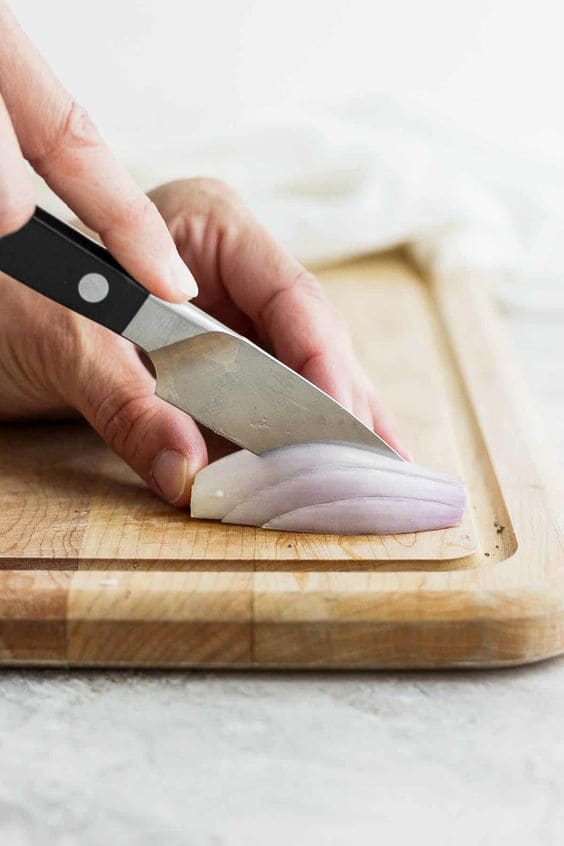
Dicing
- Step 1: Cut off the stem end of the shallot and slice it in half lengthwise, keeping the root end intact.
- Step 2: Peel off the papery skin from each half of the shallot.
- Step 3: Lay each half of the shallot flat on the cutting board and slice it crosswise into thin strips, leaving the root end intact.
- Step 4: Rotate the shallot 90 degrees and make several horizontal cuts, again leaving the root end intact.
- Step 5: Finally, make vertical cuts down the shallot, creating small cubes.
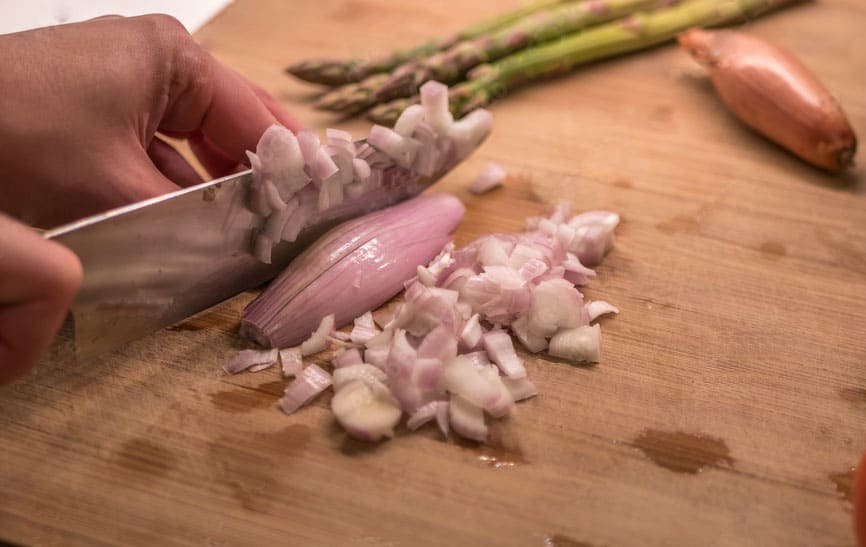
Minced
- Step 1: Cut off the root and stem ends of the shallot and discard them.
- Step 2: Cut the shallot in half lengthwise.
- Step 3: Peel off the papery skin from each half of the shallot.
- Step 4: Place one half of the shallot flat on the cutting board, and make several vertical cuts through the shallot, being careful not to cut all the way through the root end.
- Step 5: Then, make several horizontal cuts across the shallot, creating small pieces.
- Step 6: Finally, turn the shallot 90 degrees and make several vertical cuts, creating small pieces. Repeat the process with the other half of the shallot.
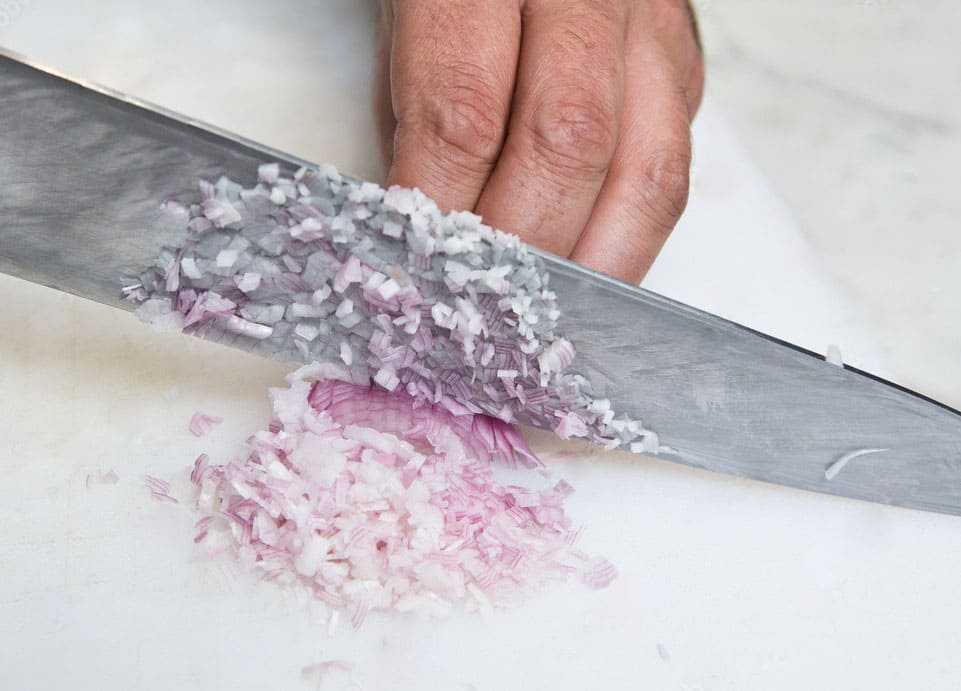
By using these techniques, you can cut shallots in different ways according to your recipe. Be sure to use a sharp knife and take your time to make clean, even cuts. With a little practice, you’ll be able to cut shallots like a pro.
Tips for How to Cut Shallots
To make the task easier, there are several tips you can follow when cutting shallots:
How to hold the knife?
Grip the handle of the knife firmly with your dominant hand, and wrap your other hand around the blade near the base. This will help you to control the knife and prevent injuries.
How to hold the shallot?
Place the shallot on a cutting board and cut off the top and bottom ends. Peel off the skin, and then cut the shallot in half lengthwise, leaving the root end intact.
How to cut shallots without crying?
- Chill the shallots: Place the shallots in the refrigerator for 10-15 minutes before cutting. The cold temperature can help reduce the amount of gas released when you cut into the shallot.
- Cut under running water: Another way to reduce the gas released when cutting shallots is to cut them under running water. This can help to wash away the gas before it reaches your eyes.
- Use a sharp knife: A sharp knife will make cleaner cuts and cause less damage to the shallot, which can reduce the amount of gas released.
- cut quickly: The longer you take to cut the shallots, the more gas will be released, so try to work quickly and efficiently.
- Use a ventilated area: Cutting shallots in a well-ventilated area can help to disperse the gas and reduce the amount that reaches your eyes.
How to avoid injuries?
Always use a sharp knife and keep your fingers away from the blade. Use a claw grip to hold the shallot in place, and cut slowly and carefully.
How to cut shallots for roasting?
- Peel the shallots: Remove the papery skin and cut off the top, bottom ends of the shallots.
- Cut the shallots into quarters: Cut each shallot in half lengthwise, starting at the top and cutting towards the root end. Leave the root end intact to hold the halves together. Then, cut each half in half lengthwise again, so you have four quarters.
- Toss with oil and seasonings: Place the shallot quarters in a bowl and toss with olive oil, salt, and pepper, or any other seasonings of your choice.
- Roast in the oven: Preheat your oven to 400°F. Place the seasoned shallots on a baking sheet and roast in the oven for 20-25 minutes, or until they are tender and caramelized.
- Serve and enjoy: Once the shallots are roasted to perfection, serve them as a side dish, add them to salads or sandwiches, or use them as a topping for meats or vegetables.
How to cut shallots for frying?
Slice the shallots thinly crosswise, and then separate them into individual rings. Dredge them in flour or cornstarch and fry them until they are crispy and golden brown.
How to slice shallots into rings?
Cut off the top and bottom ends of the shallot, and then slice it crosswise into thin rings. Use a claw grip to protect your fingers while cutting.
How to cut shallots into wedges?
To cut shallots into wedges, start by peeling the shallot and then cutting off the top and bottom ends. Cut the shallot in half lengthwise, and then cut each half into 2-3 wedges, depending on the size of the shallot. Leave the root end intact to hold the wedges together. Once you have the wedges, you can roast them in the oven, sauté them on the stovetop, or use them in any recipe that calls for shallot wedges.
How to cut shallots for steak?
Here are the steps for cutting shallots for steak:
- Peel the shallots: Remove the papery skin from the shallots and discard. Cut off the top and bottom ends of the shallots.
- Cut the shallots lengthwise: Cut each shallot in half lengthwise, starting at the top and cutting towards the root end. Leave the root end intact to hold the halves together.
- Slice the shallots thinly: Place the shallot halves cut-side down on the cutting board. Use a sharp knife to slice the shallots thinly lengthwise, making sure to keep the root end intact.
- Sauté the shallots: Heat some oil or butter in a skillet over medium heat. Once hot, add the sliced shallots and cook, stirring frequently, until they are caramelized and tender. This usually takes about 5-7 minutes.
- Serve with steak: Once the shallots are cooked, spoon them over your grilled or roasted steak to add a burst of flavor. You can also use them as a topping for other meats or vegetables.
How to cut a shallot lengthwise?
To cut a shallot lengthwise, start by cutting off the top and bottom ends of the shallot with a sharp knife. Then, slice the shallot in half lengthwise, starting at the root end and cutting towards the top end. Leave the root end intact to hold the halves together. Once you have the halves, you can further slice them into thin strips or chop them into small pieces. Be sure to use a sharp knife and a steady hand to make clean, even cuts.
How to Cook Shallots?
Shallots are a versatile ingredient that can add depth and flavor to a variety of dishes. From salads and soups to stir-fries and sauces, shallots can be used in many different ways to enhance the taste of your favorite recipes. Here are some popular dishes that use shallots, along with step-by-step instructions on how to incorporate shallots in each dish:
Shallot Vinaigrette
This tangy and flavorful dressing is perfect for salads or as a marinade for grilled meats. To make the vinaigrette, finely chop one shallot and mix it with olive oil, red wine vinegar, Dijon mustard, and a pinch of salt and pepper. Whisk the ingredients together until well combined, and then drizzle over your favorite greens.
Shallot soup
This rich and comforting soup is a classic French dish that showcases the sweet and savory flavor of shallots. To make the soup:
- Sauté sliced shallots in butter until caramelized
- Then add chicken or vegetable stock and simmer for 30-40 minutes
- Finish the soup with a splash of sherry vinegar and some fresh thyme leaves.
Shallot risotto
This creamy and flavorful dish is perfect as a main course or a side dish. To make the risotto:
- First, Sauté chopped shallots in butter until translucent
- Next, add Arborio rice and cook until toasted.
- Gradually add hot chicken or vegetable stock, stirring constantly, until the rice is cooked and the mixture is creamy.
- Finally, finish the risotto with grated Parmesan cheese and chopped fresh herbs.
See more: How To Grate Cheese Without A Grater Like A Pro?
Shallot and mushroom stir-fry
This quick and easy dish is perfect for a weeknight dinner. To make the stir-fry:
- Sauté sliced shallots and mushrooms in a hot wok or skillet
- Then add soy sauce, oyster sauce, and a pinch of sugar.
- Cook until the vegetables are tender and the sauce is thick and glossy,
- Lastly, serve with steamed rice.
Shallot gravy
This rich and flavorful gravy is perfect for roasted meats or mashed potatoes. To make the gravy:
- Sauté sliced shallots in butter until caramelized
- Then whisk in flour and cook until lightly browned.
- Gradually whisk in chicken or beef stock, stirring constantly, until the gravy is thick and smooth.
- Season with salt and pepper to taste.
Storing Shallots
Storing shallots properly can help them stay fresh and flavorful for longer. Here are some tips on how to store uncut and cut shallots:
How to store uncut shallots?
- Keep them in a cool, dry, and well-ventilated place, such as a pantry or a cupboard.
- Store them in a mesh bag or a paper bag to help them stay dry and prevent moisture buildup.
- Avoid storing them in plastic bags or containers, which can trap moisture and cause the shallots to rot.
- Separate the shallots from other vegetables and fruits to prevent them from ripening too quickly.
- Do not store them near sources of heat, such as the stove or the oven, which can cause them to spoil.
- Check the shallots regularly for any signs of spoilage, such as mold, soft spots, or a foul odor, and discard any that are no longer fresh.
How to store cut shallots?
- Wrap the cut shallots in plastic wrap or aluminum foil to protect them from moisture and air.
- Alternatively, you can store cut shallots in an airtight container with a tight-fitting lid.
- Label the container or the wrap with the date that you cut the shallots.
- Store the cut shallots in the refrigerator, either in the crisper drawer or on a shelf.
- Make sure the refrigerator temperature is set to below 40°F (4°C) to keep the shallots fresh for longer.
- Use the cut shallots within 3-5 days. If they start to smell bad or develop mold, discard them immediately.
How long do cut shallots last?
Cut shallots can last for up to 5 days in the refrigerator if they are stored properly. It’s important to wrap them tightly in plastic wrap or aluminum foil or store them in an airtight container with a tight-fitting lid. Additionally, it’s essential to check the shallots for any signs of spoilage before using them. If they have a foul odor, slime, or mold, discard them immediately.
FAQs
How do I know if a shallot is still fresh?
You can tell if a shallot is fresh by checking for any signs of spoilage, such as mold, slime, or a foul odor. The shallot should also be firm and have a dry papery skin.
Is it necessary to use a specific knife for cutting shallots?
While it’s not necessary to use a specific knife for cutting shallots, using a sharp knife will make the process easier and help you achieve more precise cuts.
Can I use a food processor to chop shallots?
Yes, you can use a food processor to chop shallots. However, be careful not to over-process them, as they can quickly turn into a puree.
Can you cut shallots ahead of time?
Yes, you can cut shallots ahead of time, but make sure to store them properly in an airtight container in the refrigerator. Cut shallots can last for up to 5 days in the fridge if stored correctly.
Conclusion
As a result, knowing how to cut shallots is a valuable skill that can elevate the flavors of many dishes. By following the simple steps outlined in this article, you can easily prepare shallots for use in a variety of recipes. Remember to first remove the papery outer layer and cut off the root end, then slice the shallot vertically into thin strips before dicing it crosswise. This will result in small, uniform pieces that will cook evenly and impart a subtle, sweet flavor to your dishes. With these tips and tricks, you can add shallots to your cooking skills with confidence and make tasty meals that will impress your family and friends.

